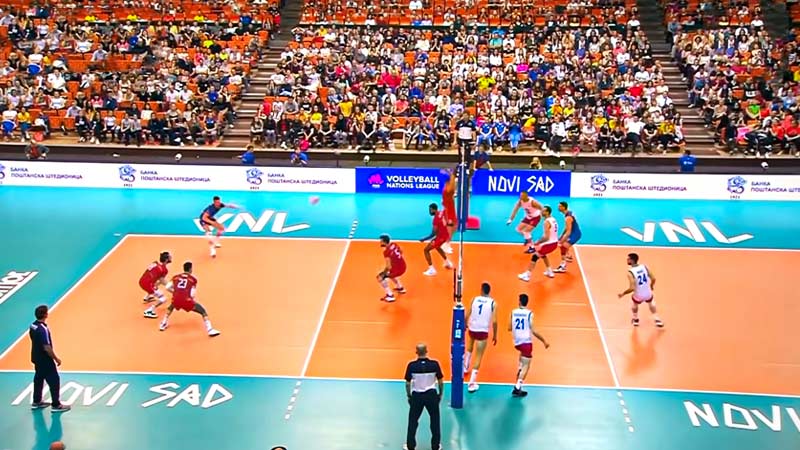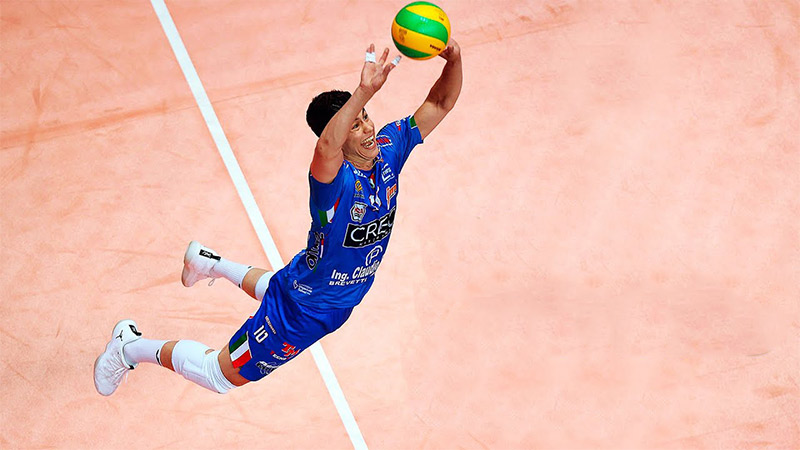Volleyball is a dynamic and thrilling sport that demands coordination, teamwork, and strategy. To the uninitiated, it might appear as a simple game of hitting a ball over the net, but it’s a sport with intricate positioning and specialized roles.
In this blog post, we dive into the world of volleyball positions, shedding light on the critical roles each player plays on the court. From the setter’s precision in orchestrating the offense to the libero’s mastery of defense, each position carries unique responsibilities that contribute to a team’s success.
Whether you’re a seasoned player looking to deepen your understanding or a newcomer eager to grasp the fundamentals, this guide will unravel the mysteries of volleyball positions, their significance, and how they come together to create the breathtaking spectacle that is volleyball.
Is There Positions In Volleyball?
Yes, volleyball has specific positions that players occupy on the court. There are six primary positions: three in the front row and three in the back row. In the front row, you have the outside hitter, middle blocker, and opposite hitter.
The outside hitter usually attacks from the left side, the middle blocker from the center, and the opposite hitter from the right. In the back row, you have the setter, libero, and defensive specialist.
The setter is responsible for setting up the attackers, while the libero specializes in defensive skills and typically replaces a back-row player. The defensive specialist may substitute for specific back-row players for defensive purposes. Each position has distinct responsibilities, such as blocking, attacking, digging, or setting.
Players rotate clockwise when their team wins the serve, allowing each player to experience different positions on the court. Effective positioning and teamwork are crucial in volleyball to maximize offensive and defensive strategies, making it a dynamic and engaging team sport.
What Are the 7 Positions in Volleyball?
There are 7 specific positions in volleyball, and each player on a volleyball team has a designated position with distinct roles and responsibilities. The main positions in volleyball are:
Outside Hitter (Left Side Hitter)
The outside hitter usually plays on the left front of the net. They are often the primary attackers and are responsible for both hitting and blocking on the left side of the court.
Opposite Hitter (Right Side Hitter)
The opposite hitter typically plays on the right front of the net. They are also primary attackers, and their role is to provide balance to the outside hitter by attacking from the right side.
Middle Blocker
The middle blocker plays at the net in the center. They are responsible for blocking the opposing team’s attacks and often have quick offensive plays called “quick sets” to surprise the defense.
Setter
The setter is like the quarterback of the team. They are responsible for setting up the ball for the attackers by delivering precise passes. Setters are usually positioned in the back row and front row and have a unique role in orchestrating the team’s offense.
Libero
The libero is a defensive specialist. They wear a different colored jersey and have specific rules, like not being allowed to attack the ball above net height. Liberos excel in passing, digging, and serving to receive. They often replace back-row players to enhance the team’s defense.
Defensive Specialist
Some teams may have additional players specializing in defense or serving. These players typically substitute for back-row players to provide better ball control or serve accuracy.
Utility Player
In some cases, a player may be versatile and capable of playing multiple positions. Utility players can adapt to various roles as needed during a match.
The specific positions and roles can vary depending on the level of play and team strategy. In professional and international volleyball, players often specialize in their positions, while in recreational or amateur play, players may have more flexible roles.
General Volleyball Positions and Roles

In volleyball, there are several general positions and roles that players typically fill on a team. These positions and roles include:
Setter (Position 1)
- Role: The setter is responsible for setting up the ball for the attackers. They are like the playmaker, deciding which attacker to set the ball to and ensuring accurate and hittable sets.
- Location: Typically positioned in the right-back (Position 1) when in the back row and the right-front (Position 3) when in the front row.
Outside Hitter (Left Side Hitter) (Positions 4 and 5)
- Role: The outside hitters are the primary attackers on the left side of the court. They receive sets from the setter and are responsible for hitting and blocking on the left side.
- Location: Positioned in the left-front (Position 4) when in the front row and left-back (Position 5) when in the back row.
Opposite Hitter (Right Side Hitter) (Positions 2 and 3)
- Role: The opposite hitter is the primary attacker on the right side of the court. They provide balance to the offense and are responsible for both hitting and blocking on the right side.
- Location: Positioned in the right-front (Position 2) when in the front row and right-back (Position 3) when in the back row.
Middle Blocker (Positions 3 and 4)
- Role: Middle blockers specialize in blocking and quick attacks. They are responsible for blocking the opposing team’s hitters and executing quick offensive plays in the center.
- Location: Positioned in the center-front (Position 3) when in the front row and center-back (Position 4) when in the back row.
Libero (Designated Back-row Player)
- Role: The libero is a defensive specialist. They excel at passing, digging, and serving to receive. Liberos wear a different colored jersey and cannot attack the ball above net height.
- Location: The libero replaces a back-row player and can play in the back row in any position but cannot play in the front row.
Defensive Specialist (DS)
- Role: Similar to the libero, defensive specialists focus on passing, digging, and serving. They may substitute for back-row players to improve ball control or serve accuracy.
- Location: Defensive specialists typically play in the back row, replacing a back-row player when needed.
Utility Player
Some players may have the flexibility to play multiple positions and roles based on the team’s needs. Utility players adapt to various roles during a match.
These are the primary positions and roles in volleyball, but there can be variations and specific strategies depending on the team’s goals and playing style.
Core Strategies of the Volleyball Positions
Core strategies in volleyball focus on fundamental principles that teams use to achieve success. These strategies encompass various aspects of the game, including offense, defense, and teamwork. Here are some core strategies in volleyball:
Serve Receive
Efficient serve-receive is fundamental to starting an effective offensive play. Teams must ensure accurate and stable passing to set up the attack. This involves good communication between passers and the setter.
Setter-Hitter Connection
Establishing a strong connection between the setter and hitters is vital. Hitters must anticipate the setter’s location and timing of sets, while setters must read the defense and make precise decisions about which hitter to set.
Attack Variety
Effective offenses use a variety of attacks, including quick sets in the middle, outside hits, back-row attacks, and off-speed shots. This keeps the opposing defense guessing and creates opportunities for scoring.
Blocking
Blocking at the net is a key defensive strategy. Teams aim to block the opponent’s attacks to disrupt their offense and score points directly off blocks.
Defense and Digging
Strong defensive play involves digging the opponent’s attacks and converting those digs into effective passes for the setter. Liberos and defensive specialists excel in this aspect of the game.
Transition Play
Teams work on transitioning smoothly from defense to offense. Quick and effective transitions can catch the opposing defense off guard, leading to scoring opportunities.
Communication
Effective communication is essential for coordination on the court. Players communicate to call for the ball, signal plays, and provide feedback to teammates.
Serve and Serve Reception
Serving aggressively to disrupt the opponent’s offense while maintaining consistency is a key strategy. Teams also focus on handling tough serves from the opposing team.
Blocking Coverage
After blocking, players need to be in the right position to cover the court and defend against any deflected balls.
Team Chemistry
Building a strong team dynamic is crucial. Trust and camaraderie among teammates enhance performance and teamwork on the court.
Scouting Opponents
Teams often scout their opponents to learn their tendencies and weaknesses. This knowledge helps formulate specific strategies for each match.
Adaptability
Volleyball is a fast-paced game, and teams must adapt to changing circumstances during a match. Being flexible in strategy and making quick adjustments is vital.
Serving Targets
Serving to specific areas of the court can disrupt the opponent’s passing and create favorable situations for defense and blocking.
Timeouts and Momentum Shifts
Effective use of timeouts can help a team regroup, regain focus, and shift momentum in their favor during a match.
These core strategies, when executed well, contribute to a team’s success in volleyball. Teams often develop their unique strategies and tactics based on their strengths, weaknesses, and playing style.
FAQs
What are the 6 Positions in Volleyball?
The six positions in volleyball are setter, outside hitter, opposite hitter, middle blocker, libero, and defensive specialist. The setter orchestrates the offense, while outside and opposite hitters are primary attackers.
Middle blockers focus on blocking and quick attacks. Liberos are defensive specialists, and defensive specialists assist with passing and defense.
What is the primary role of a setter in volleyball?
The setter’s main role is to deliver accurate sets to the attackers, facilitating successful spikes. They act as the team’s playmaker, making split-second decisions to distribute the ball effectively.
Can a player switch positions during a volleyball match?
In most cases, players maintain their positions throughout a match. However, some substitutions are allowed, especially for back-row specialists like liberos or defensive specialists.
What does the libero position entail in volleyball?
The libero is a defensive specialist responsible for excellent passing, digging, and serving to receive. They wear a different colored jersey, have unique rules, and often replace a back-row player to enhance the team’s defense.
Are positions in volleyball fixed, or can players be versatile?
While players typically specialize in specific positions, some may have versatility and adaptability, allowing them to play multiple roles as needed. Versatile players can provide flexibility and strategic advantages for the team.
Wrapping Up
In the world of volleyball, positions are not just markers on the court; they are the pillars upon which successful teams are built. As we’ve explored the setter’s artistry, the outside hitter’s power, and the libero’s defensive prowess, it becomes evident that every player’s role is vital.
It’s the synergy of these positions and their flawless execution that transforms a simple serve-and-spike game into an electrifying sport loved by millions worldwide.
Positions in volleyball is not merely about knowing where to stand but recognizing the beauty of a well-coordinated team working together to spike, block, and dig their way to victory. Best wishes.







